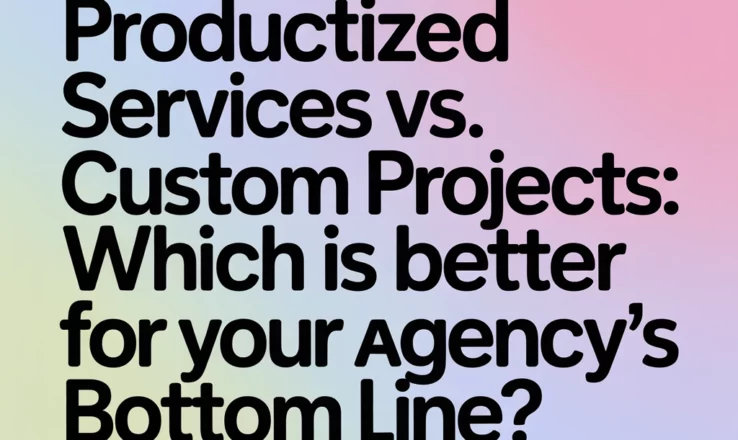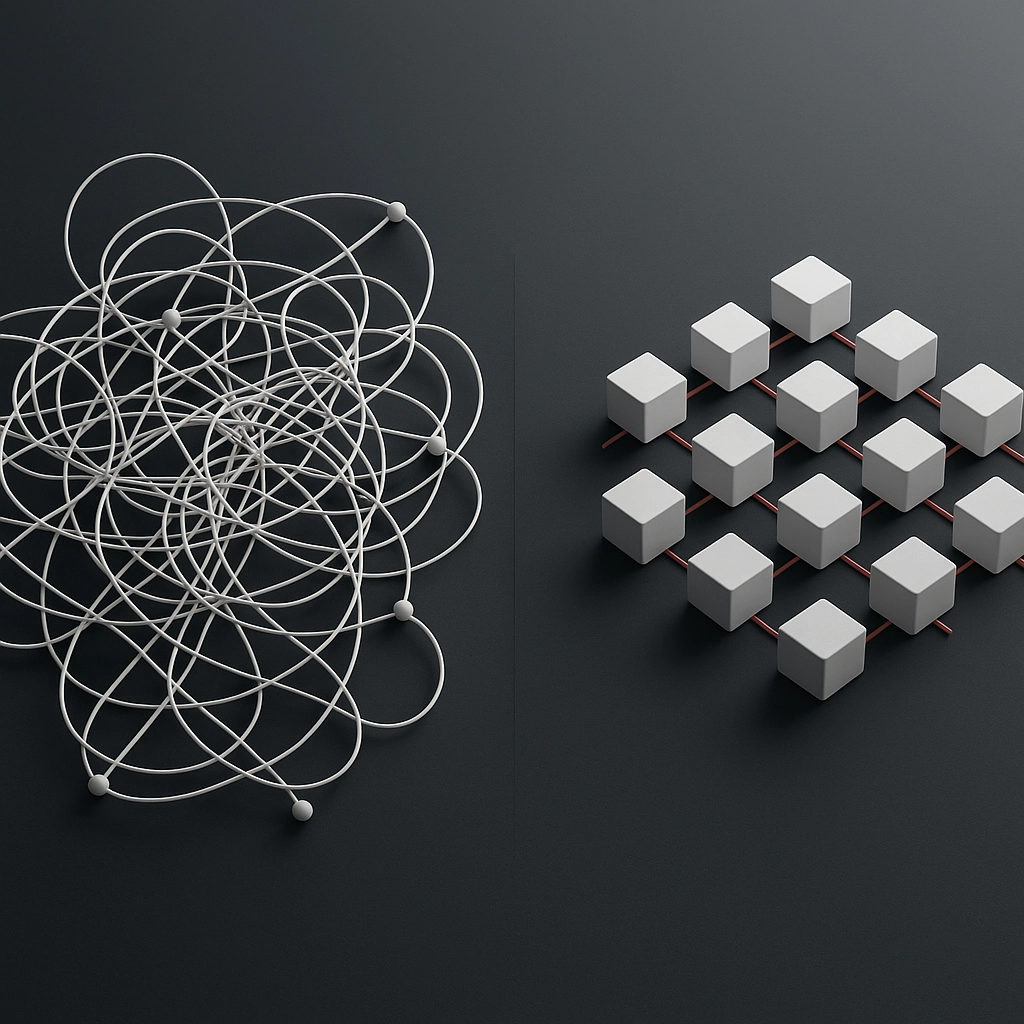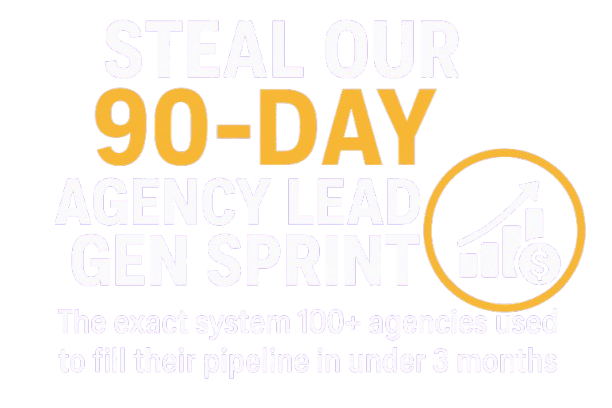
Here's the reality every agency founder faces: you're constantly choosing between two fundamentally different business models. Do you package your expertise into standardized offerings, or do you craft bespoke solutions for each client? This decision shapes everything—your profit margins, operational complexity, team structure, and growth trajectory.
Stop making this choice based on gut feeling. Today, we're going to break down the financial mechanics of both models so you can make data-driven decisions about your agency's future.
The Productized Services Model: Your Profit Engine
Let me walk you through what productized services actually mean for your bottom line. You're taking your core expertise and packaging it into standardized, repeatable offerings with fixed pricing, defined scope, and predictable deliverables.
Here's what this looks like in practice: Instead of proposing a "comprehensive digital marketing strategy" for $15,000-$50,000, you create specific packages—a $5,000 "SEO Foundation Audit," a $3,500 "PPC Account Setup & Optimization," or a $7,500 "Content Marketing Launch Package."
The Financial Mechanics That Drive Profit
Your profit margins increase dramatically because you eliminate the inefficiencies that destroy custom project profitability. No more scope creep eating into margins. No more endless revision cycles. No more project management overhead that scales linearly with complexity.
Calculate your current project profitability this way: Take your average project value and subtract all direct costs (team time at loaded rates, tools, subcontractors). Then subtract indirect costs (project management, client communication, revisions). What's left? For most agencies running custom work, it's 15-25% if they're lucky.
Now run the same calculation on a productized service. Your 40-hour SEO audit becomes a systematic process: 8 hours for technical analysis, 12 hours for content gap assessment, 8 hours for competitive research, 12 hours for report creation and presentation. Total: 40 hours at $150/hour loaded rate = $6,000 costs against a $8,500 package price. That's 29% margin before you optimize the process.
But here's where it gets interesting: After delivering this package 10 times, you've built templates, automated data collection, streamlined reporting. Those 40 hours become 28 hours. Your margin jumps to 42%. After 25 deliveries, you're down to 22 hours. Now you're at 60% margin.
The Operational Advantages That Scale Your Business
Productized services let you benchmark performance across deliveries. Track these metrics monthly:
- Time to completion vs. standard
- Client satisfaction scores by package
- Upsell conversion rates
- Team utilization rates
You can't do this effectively with custom work because every project is a unique snowflake. With productized services, you identify bottlenecks, optimize processes, and scale team members who excel at specific deliverables.

Custom Projects: The Premium Positioning Play
Custom projects position your agency at the top of the market. You're not selling packages—you're selling strategic thinking, unique solutions, and transformational outcomes.
Here's the financial reality: Custom projects command premium pricing because clients perceive higher value in bespoke solutions. A custom digital transformation strategy might range from $75,000 to $500,000, depending on client size and scope.
The Revenue Mechanics of Custom Work
Your average project values increase significantly with custom work. Instead of selling $5,000 packages, you're proposing $50,000 engagements. But here's what most agency founders miss: higher project values don't automatically mean higher profits.
Custom projects require deeper discovery phases, more senior resources, longer sales cycles, and higher risk of scope changes. Calculate your true cost structure:
- Discovery and proposal development: 20-40 hours pre-sale
- Project management overhead: 15-25% of total project hours
- Senior resource requirements: $200-300/hour loaded rates
- Risk buffer for scope changes: 10-20% of total project cost
A $100,000 custom project might require 400 hours at blended rates of $175/hour ($70,000), plus 60 hours of project management ($12,000), plus discovery costs ($6,000). Your gross margin: 12% before accounting for business development costs and failed proposals.
The Strategic Value of Custom Positioning
But custom work provides strategic advantages that pure financial analysis misses. You build deeper client relationships, gain access to C-suite decision makers, and create case studies that differentiate your agency from commodity providers.
Custom clients also tend to have larger budgets for follow-on work. A successful $200,000 custom engagement often leads to $500,000+ in additional projects over 24 months.
The Bottom Line Analysis: Which Model Wins?
Let me show you the financial comparison that matters:
| Metric | Productized Services | Custom Projects |
|---|---|---|
| Average Project Value | $3,000 – $25,000 | $50,000 – $500,000 |
| Gross Profit Margin | 35-65% (optimized) | 15-35% |
| Sales Cycle Length | 2-4 weeks | 8-16 weeks |
| Project Risk Level | Low (fixed scope) | High (scope creep) |
| Team Utilization | 75-85% | 60-70% |
| Revenue Predictability | High (recurring packages) | Variable |
| Scaling Complexity | Low (standardized processes) | High (custom delivery) |
Here's the framework I use to determine which model works for specific agency situations:
Choose Productized Services When:
- Your monthly recurring revenue is below $50,000
- You need predictable cash flow to fund growth
- Your team has specialized expertise that can be systematized
- You want to serve mid-market clients efficiently
- You're building for acquisition (buyers love predictable revenue)
Choose Custom Projects When:
- You have deep expertise in transformation-level engagements
- Your target clients have budgets exceeding $100,000 annually
- You can secure multi-year strategic partnerships
- Your agency principals enjoy complex problem-solving
- You're building a premium brand for long-term positioning
The Hybrid Model: Maximum Financial Optimization
The most profitable agencies combine both approaches strategically. Here's the framework I've developed after analyzing 200+ agency financial models:
Start with productized services to create your revenue foundation. Build 3-5 core packages that generate $30,000-$50,000 monthly recurring revenue. This provides cash flow stability and operational efficiency.
Then layer custom projects for growth acceleration. Use your productized services to attract and vet potential custom clients. A client who succeeds with your $10,000 package becomes a qualified prospect for your $100,000 custom engagement.
Structure your service portfolio like this:
- Foundation Packages (60% of revenue): Standardized, high-margin offerings
- Growth Packages (25% of revenue): Semi-custom solutions with defined parameters
- Transformation Engagements (15% of revenue): Fully custom, high-value projects
This hybrid approach optimizes for both profitability and growth. Your productized services provide operational efficiency and predictable margins. Your custom projects drive average project values and market positioning.
Implementation Roadmap: Transform Your Service Model
Here's exactly how to transition your current agency model:
Phase 1: Audit Your Current Profitability (Week 1-2)
Calculate true profitability by project for the last 12 months. Identify your most profitable service types, client sizes, and engagement models. This becomes your baseline for optimization.
Phase 2: Design Your Package Architecture (Week 3-4)
Take your most profitable services and reverse-engineer them into standardized packages. Define exact deliverables, timelines, and resource requirements. Price packages at 40-50% margin targets.
Phase 3: Test and Optimize (Month 2-3)
Launch 2-3 productized packages with existing clients or new prospects. Track delivery time, client satisfaction, and actual vs. planned profitability. Optimize processes based on real delivery data.
Phase 4: Scale the Winners (Month 4-6)
Double down on packages with highest demand and best margins. Build team specialization around these offerings. Create systems for consistent delivery at scale.
Remember: This transition isn't just about changing what you sell—it's about fundamentally restructuring how your agency operates for maximum profitability.
The agencies that master this strategic choice don't just survive—they build sustainable, profitable businesses that provide both financial freedom and strategic flexibility. Now pick your model, build your implementation plan, and execute with the precision your bottom line demands.
